|
|
 |
|
Calanoida ( Order ) |
|
|
|
Arietelloidea ( Superfamily ) |
|
|
|
Heterorhabdidae ( Family ) |
|
|
|
Heterorhabdus ( Genus ) |
|
|
| |
Heterorhabdus austrinus Giesbrecht, 1902 (F,M) | |
| | | | | | | Syn.: | no Heterorhabdus austrinus : Wolfenden, 1905 a (p.13, Descr.M, fig.M); no Bradford, 1971 b (fig. 96: M);
no Alloiorhabdus austrinus : Wolfenden, 1911 (p.304) | | | | Ref.: | | | Giesbrecht, 1902 (p.28, Descr.F, figs.F); Brady, 1918 (p.27, figs.F,M); Farran, 1929 (p.209, 265, fig.M, Rem.); ervoort, 1951 (p.127, Rem.); 1957 (p.131, figs.M, Rem.); Ramirez, 1969 (p.77, figs.F, Rem.); Bradford, 1970 a (p.358, figs.F,M, Rem.); 1971 a (p.122, 123, figs.F,M, Rem.); 1971 b §p.24, fig.F): Zvereva, 1972 (1975) (p.256, figs.F); Séret, 1979 (p.146, figs.F,M); Björnberg & al., 1981 (p.650, figs.F, M, Rem.); Razouls, 1994 (p.159, figs.F,M, Rem.); Bradford-Grieve & al., 1999 (p.883, 944, figs.F,M); Bradford-Grieve,1999 b (p.77, figs.F, Rem., figs.174, 191); Park, 2000 (p.132, figs.F,M, Rem.); Xavier & al., 2020 (p.25, fig., Rem.). | 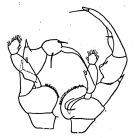 issued from : G.P. Farran in British Antarctic (\"Terra Nova\") Expedition, 1910. Natural History Reports. Zoology. Vol. VIII. Crustacea, 1929. [p.265, Fig.26]. Male: fifth feet.
|
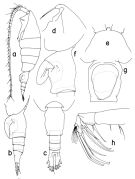 issued from : T. Park in Bull. Scripps Inst. Oceanogr. Univ. California, San Diego, 2000, 31. [p.256, Fig.104]. Female: a, habitus (left side); b, c, urosome (left, dorsal, respectively); d, e, forehead (left, dorsal, respectively); f, g, genital somite (left, ventral, respectively); h, left Mx2 (posterior). Nota: Mx2: Spine of 2nd lobe relatively thin and short, posterior subterminal spine of 4th lobe 51% as long as 2nd saberlike spine, which is a little longer than 1st saberlike spine; falcate spine of 5th lobe about 1/3 times length of saberlike spine, with proximal 54% of medial margin serrated with spinules; falcate spine of 6th lobe with about 67% of medial margin serrated with spinules.
|
 issued from : T. Park in Bull. Scripps Inst. Oceanogr. Univ. California, San Diego, 2000, 31. [p.257, Fig.105]. Female: a, exopod of P1 (anterior); b, P5 (posterior). Male: c, P5 (anterior); d, e, f, basipod of right P5 (anterior, tilted clockwise, posterior, respectively); g, distal end of exopod of right P5 (lateral); h, exopod of left P5 (anterior); i, j, second exopodal segment of right P5 (anterior, posterior, respectively).
|
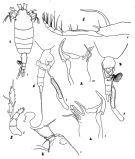 issued from : J.A. Zvereva in Issled. Fauny Moreï, 1972, 12 (20). [p.222, Fig.4]; Female: 1, habitus (dorsal); 2, forehead (left lateral side); 3, masticatory edge of left Md; 4, masticatory edge of right Md; 5, Mxp; 6, urosome (right lateral side) with spermatophore; 7, idem (ventral); 8, P5.
|
 issued from : J.M. Bradford-Grieve in The Marine Fauna of New Zealand: Pelagic Calanoid Copepoda. National Institute of Water and Atmospheric Research (NIWA). NIWA Biodiversity Memoir, 111, 1999. [p.78, Fig.44]. Female: A, habitus (dorsal); B, urosome (dorsal); C, D, genital somite (left side). Male: E, P5 (L = left leg; R = right leg).
|
 issued from : J.M. Bradford in N.Z. Jl Mar. Freshw. Res., 1970, 4 (4). [p.358, Figs 46-50 ]. Female (off Kaikoura, New Zealand): 46, left Md; 47, right Md; 48, urosome (lateral left side); 49, 3rd exopod of P3; 50, P5. Scale bars represent 0.1 mm.
|
 issued from : J.M. Bradford in N.Z. Jl Mar. Freshw. Res., 1970, 4 (4). [p.358, Fig.51]. Male (off Kaikoura, New Zealand): 51, P5. Scale bars represent 0.1 mm.
|
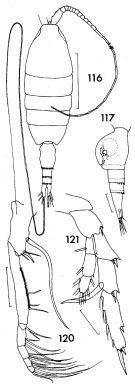 issued from : F.C. Ramirez in Contr. Inst. Biol. mar., Buenos Aires, 1969, 98. [p.78, Lam. XV, figs.116, 117, 120, 121]. Female (from off Mar del Plata): 116, habitus (dorsal); 117, urosome (lateral left side); 120, Mxp; 121, P5. Scale bars in mm: 1 (116); 0.2 (117); 0.15 (120); 0.05 (121).
|
 issued from : W. Vervoort in B.A.N.Z. Antarctic Reseach Expedition, Report Ser. B, Vol. III, 1957 [Fig.122]. Male (from 66°11'S, 65°10'E):P5 (rt = right leg; lt = left leg).
|
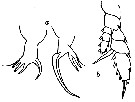 issued from : R.N. Wolfenden in Die Marinen Copepoden der Deutschen Südpolar-Expedition 1901-1903, 1911. [p.304, Fig.54]. Female: a, right and left Md; b, P5.
|
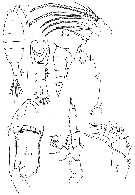 issued from : W. Giesbrecht in Copepoden. Res. voyage du S. Y. Belgica. Rapports scientifiques, Zoologie, 1902. [Taf. VI, Figs. 1-9]. Female (from S Peter Ist Island): 1, dorsal; 2, forehead (lateral); 3, urosome (ventral); 4, idem (lateral); 5, A1 (proximal segments); 6, Mx2 (distal part); 7, Mxp; 8, exopodite 3 of P3; 9, P5.
|
 Issued from : J.M. Bradford in N.Z. Oceanogr. Inst., 1971, 206, Part 8, No 59. [p.24, Figs.93-95]. Female (from Ross Sea): 93-94, lateral views of genital and urosomal 2nd segments; 95, P5.
|
 Heterorhabdus austrinus Heterorhabdus austrinus female: 1 - See key to species groups of Heterorhabdus: ''abyssalis'' Group (p.90, 114). 2 - Genital somite without a conical projection mediodorsally (Fig.104-a, c). 3 - Laterally, genital somite without a tubercular outgrowth posteriorly on dorsal margin (Fig.104-b, f). 4 - Laterally, genital somite with a tubercular outgrowth posteriorly on ventral margin (Fig.104-f). 5 - Laterally, genital operculum reaching close to posterior end of somite (Fig.104-b).
|
 Heterorhabdus austrinus Heterorhabdus austrinus male: 1 - See key to species groups of Heterorhabdus: ''abyssalis'' Group (p.90, 114). 2 - Basis of left P5 without a well-developed inner lobe (Fig.105-c). 3 - Basal inner lobe of right P5 armed with normal bristles (Fig.105-c, d). 4 - 3rd exopodal segment of right P5 with a short terminal lobe, slightly less than 1/3 length of terminal spine (Fig.105-c, g). 5 - Basal lobe of right P5 arising from anteromedial side of segment (Fig. 105-c, d). 6 - 2nd exopodal segment of left P5 with outer spine borne on a conical process (Fig.105-i). 7 - Basal lobe of right P5 straight or slightly curved (Fig.105-c). 8 - Basal lobe of right P5 with an single band of bristles (Fig.105-f). 9 - Basal lobe of right P5 with narrow beginning (Fig.105-c). 3rd exopodal segment of right P5 with terminal spine about 1/4 to 1/5 length of segment.
|
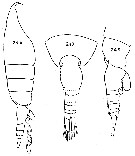 Issued from : C. Séret in Thesis 3ème Cycle, UPMC, Paris 6. 1979 [Pl. XXXVII, Figs.246-248]. Female (from off Kerguelen Is.): 246, habitus (lateral) with spermatophore; 247, last thoracic segment and urosome (dorsal); 248, same (lateral).
|
 Issued from : C. Séret in Thesis 3ème Cycle, UPMC, Paris 6. 1979 [Pl. XXXVIII, Figs.249-251 a, b]. Male: 249, habitus (dorsal); 250 a, left P5; 250 b, right P5; 251 a, left P5 (2nd individual); 251 b, right P5 (2nd individual).
|
 issued from : J.M. Bradford in N.Z. Jl mar. freshw. Res., 1971, 5 (1). [p.122, Table 1): Differences between H. norvegicus, H. autrinus and H. spinosus.
|
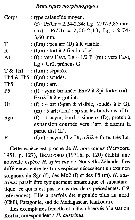 Issued from : C. Razouls in Ann. Inst. océanogr., Paris, 1994, 70 (1). [p.159]. Caractéristiques morphologiques de Heterorhabdus austrinus femelle et mâle adultes. Terminologie et abbréviations: voir à Calanus propinquus. Nota: A la station ''Kerfix'', à l'entrée de la Baie du Morbihan (Ïles Kerguelen), la femelle observée a une longueur totale de 3,36 mm; Pr/Ur = 2; Lg/lg = 2,59. Les Md prédentent 2 dents à gauche, tri-cuspidées à leur partie distale, et 3 à droite, dont 2 bi et tri-cuspidée. Les Mx2 sont conformes à la figure 3b in Bradford (1971, p.125) de même que le segment génital (en vue latérale). Le segment anal est court mais nettement distinct des rames caudales (surure en vue ventrale) et à peine inférieur à la longueur de Ur3. Les proportions de l'urosome en % (pris à gauche: 36/19,3/13,2/11,7/ F = 19,8. Le mâle a une longueur totale de 3,01 mm; Pr/Ur = 2,13. Séret (1979, p.147) trouve cette espèce commune autour des Ïles Kerguelen. Les longueurs respectives des femelles et mâles varient de 3,04 à 3,33 mm et 2,74 à 3,08 mm. Bradford (1970, p.358, figs. 46-51) observe cette espèce proche de la Péninsule de Kaikoura (Nouvelle- Zélande). Elle souligne l'écart des tailles: 2,40 à 4,05 mm. Ultérieurement cet auteur estime que la population initiale comprenait en réalité deux espèces: les petites formes appartenant à H. austrinus, et les plus grandes à la nouvelle espèce H. spinosus (longueur des femelles: 3,4-4,2 mm et 3,1-3,7 mm pour les mâles. La distinction entre les deux espèces paraît très faible, notamment en ce qui concerne les bords latéraux du segment génital chez la femelle. Les deux exemplaires femelles examinés à la station ''Kerfix'' montrent un segment génital, plus conforme à la fig. 2g in Bradford (1970, p.124) et la maxille présente égalent 12 soies. On note les différences suivantes; le lobe 4 de Mx2 a comme rapport de la plus grande soie sur la plus petite 2,38 et 2,43 (contre 2,9 à 3,9 chez H. spinosus); la forte soie médiane du B2 de Mxp dépasse largement la partie distale de ce segment, atteignant presque la partie distale de l'endopodite 1 (positionné dans l'alignement du B2) chez l'un et atteint la partie distale de B2 chez l'autre (examen après montage). La seconde femelle présente les caractéristiques suivantes; longueur totale = 3,11 mm; Pr/Ur = 1,88; rapport Lg/lg du Pr = 2,27 ; la séparation entre la tête et leTh1 est très difficile à observer; proportions de l'urosome en %: 41,1/16,7/14,4/9/ F (gauche) 18,7; quelques spinules sur le bord distal médian dorsal du segment génital; 12 spinules sur le bord distal dorsal de l'Ur2, 8 spinules sur le bord distal de Ur3. Les Md sont identiques pour les deux examplaires et tout à fait semblables à celles figurées in Sars (1903, Pl. LXXXI) pour H. norvegicus. Bradford (1971b, p.25) signale l'existence de H. austrinus dans la mer de Ross, dont les tailles des femelles et des mâles sont respectivement de 3,55-3,8 mm et 2,9-3,2 mm, et discute de la validité des espèces H. norvegicus, H. abyssalis, H. autralis, H. pacificus et H. tanneri. Zvereva (1972, p.256, fig.4) signale H. austrinus surle littoral antarctique (stations Molodezhnaya, 45° E). Le segment génital de la figure 4a et 4c correspond mieux à celui de Bradford (1971b, p.124) qu\"à ceux des individus récoltés à ''Kerfix'', par contre l'épine médiane de B1 n'atteint pas la partie distale de B2.
| | | | | Compl. Ref.: | | | Cleve, 1904 a (p.191); Hardy & Gunther, 1935(1936) (p.180, Rem.); Sewell, 1948 (p.519, 570, 573, 575, Rem.); Baker, 1954 (p.203, 211, fig.5); De Decker & Mombeck, 1964 (p.12); Björnberg, 1973 (p.345, 387); Hopkins, 1985 (p.197, Table 1, gut contents); Zmijewska, 1987 (tab.2a); Hopkins & Torres, 1988 (tab.1); Ward, 1989 (tab.2); Hosie & Cochran, 1994 (tab.2); Donnelly & al., 1994 (p.171, chemical composition); Ward & al., 1995 (p.195, Table 2); Errhif & al., 1997 (p.422); Mauchline, 1998 (tab.33, come austrini); Razouls & al., 2000 (p.343, tab. 3, 5, Appendix); Hunt & al., 2001 (p.374, tab.1, 2); Hunt, 2004 (p.1, 74): Berasategui & al., 2005 (p.313, fig.2); Schnack-Schiel & al., 2008 (p.1045: Tab. 2); Park & Ferrari, 2009 (p.143, Table 3, 8, fig.1, Appendix 1, biogeography); Swadling & al., 2010 (p.887, Table A1, abundance, indicator species); Yang & al., 2011 a (p.921, Table 2, inter-annual variation 1999-2006); Michels & al., 2012 (p.369, Table 1, occurrence frequency); Ojima & al., 2013 (p.1293, Table 2, 3, abundance); Lee D.B. & al., 2013 (p.1215, Table 1, abundance, composition); Bonecker & a., 2014 (p.445, Table II: frequency, horizontal & vertical distributions); Bonecker & a., 2014 (p.445, Table II: frequency, horizontal & vertical distributions); Acha & al., 2020 (p.1, Table 3: occurrence % vs ecoregions). | | | | NZ: | 8 | | |
|
Distribution map of Heterorhabdus austrinus by geographical zones
|
| | | | | | | | |  issued from A. de C. Baker in 'Discovery' Rep., 1954, 27. [p.215, Fig.5]. issued from A. de C. Baker in 'Discovery' Rep., 1954, 27. [p.215, Fig.5].
Occurrence of Heterorhabdus austrinus in all longitudes around Antarctic zone of the Southern Ocean.
The percentage frequency of occurrence in samples taken within every 20° of longitude.
Nota: During the 'Discovery' investigations some thousands of plankton samples have been taken from stations spread over the whole of the Southern Ocean at all seasons of the year, the majority south of the Antarctic Convergence. An arbitrary selection of samples has been made from hauls between the surface and a depth of 250 m, which means that they have been taken from within the limits of the Antarctic surface water.
The data suggest that the Southern Ocean is an uninterrupted circumpolar belt with more or less uniform conditions prevailing in east and west directions, the range of planktonic species of the Antarctic surface water may be expected to extend as far as these uniform conditions persist, i.e to be circumpolar. |
 Issued from : E.T. Park & F.D. Ferrari in A selection from Smithsonian at the Poles Contributions to International Polar year. I. Krupnik, M.A. Lang and S.E. Miller, eds., Publs. by Smithsonian Institution Scholarly Press, Washington DC., 2009. [p.165, Fig.1] Issued from : E.T. Park & F.D. Ferrari in A selection from Smithsonian at the Poles Contributions to International Polar year. I. Krupnik, M.A. Lang and S.E. Miller, eds., Publs. by Smithsonian Institution Scholarly Press, Washington DC., 2009. [p.165, Fig.1]
Distribution of selected pelagic calanoids Heterorhabdus austrinus of the Southern Ocean and the closest relative. |
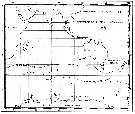 Issued from : C. Séret in Thesis 3ème Cycle, UPMC, Paris 6. 1979, Annexe. [p.48]. Issued from : C. Séret in Thesis 3ème Cycle, UPMC, Paris 6. 1979, Annexe. [p.48].
Geographical occurrences of Heterorhabdus austrinus in the Indian Ocean and Antarctic zone. [after publications from: Brady, 1883, 1918; Thompson, 1900; Wolfenden, 1908, 1911; With , 1915; Rosendorn, 1917; Farran, 1929; Sewell, 1929, 1947; Brady & Gunther, 1935; Steuer, 1929, 1392, 1933; Ommaney, 1936; Vervoort, 1957; Tanaka, 1960; Brodsky, 1964; Seno, 1966; Andrews, 1966; Grice & Hulsemann, 1967; Seno, 1966; Frost & Fleminger, 1968; Voronina, 1970; Zverva, 1972].
Nota: C. Séret notes the occurrence at stations 47°S, 66°E; 46°S, 64°E; 51°S, 65°E; 56°S, 70°E. |
 Issued from : C. Séret in Thesis 3ème Cycle, UPMC, Paris 6. 1979. [p.148, Tableau XIV]. Issued from : C. Séret in Thesis 3ème Cycle, UPMC, Paris 6. 1979. [p.148, Tableau XIV].
Cephalothorax lengths (L.Cth) in Heterorhabdus austrinus at stations 15 (46°S, 64°E), 13 (51°S, 65°E) and 12 (56°S, 70°E) in April 1974 (13, 12 and 10, respectively). |
| | | | Loc: | | | Antarct. (Amundsen Sea, Peninsula, Weddell Sea, SW & SE Atlant., Indian, Lützow-Holm Bay, SW Pacif., South Georgia, SE, Drake Passage, Prydz Bay), sub-Antarct. (SW Atlant., off W Prince Edward Is., Indian, Kerguelen Is., SW & SE Pacif.), S South Africa (E & W), S Indian (subtropical convergence), Patagonia, off S Rio de la Plata, S Brazil, off Rio de Janeiro, off Mauritania (in Lapernat, 2000, tab.3, 4), Tasman Sea, New Zealand (E South Island, SW North Island), sub-Antarct., off Chilean coast (N & S)
Type locality; 70°12'S, 84°03'W. | | | | N: | 55 | | | | Lg.: | | | (25) F: 3,6-3,02; M: 3,51-2,84; (31) F: 3,65-3,45; M: 3,42-3,38; (33) F: 3,4; (35) F: 3,85-3,42; M: 3,6-3,48; (102) F: 3,8-3,55; M: 3,2-2,9; (246) F: 3,33-3,04; M: 3,08-2,74; (313) F: 4,05-2,4; M: 2,8-2,5; (824) F: 3,68-2,84; M: 3,28-2,64; (909) F: 2,8-3,3; M: 2,7-3; {F: 2,40-4,05; M: 2,50-3,60} | | | | Rem.: | Sampling depth (Antarct., sub-Antarct.) : 0-100-1000 m.
"Abyssalis" Group.
Meso-bathypelagic.
Vervoort (1957) supposes that this species could be identical to H. pustulifer, which is contested by Bradford (1971 b).
Heterorhabdus austrinus var. Farran,1929 (F,M)
Ref.: Farran, 1929 (p.265: small forms); Vervoort, 1957 (p.132, Rem.)
Loc.: Antarct., sub-Antarct., off eastern New Zealand
Lg.: (35) F: 3,18-2,97; M: 2,88-2,84
Rem.: For Vervoort (1957) one does not observe the structural difference between this variety and the preceding species.
For Park (2000, p.135) H. austrinus is very close in habitus and details of the appendages to H. abyssalis but can be distinguished from it (See remarks in H. abyssalis). | | | Last update : 17/06/2021 | |
|
|
 Any use of this site for a publication will be mentioned with the following reference : Any use of this site for a publication will be mentioned with the following reference :
Razouls C., Desreumaux N., Kouwenberg J. and de Bovée F., 2005-2025. - Biodiversity of Marine Planktonic Copepods (morphology, geographical distribution and biological data). Sorbonne University, CNRS. Available at http://copepodes.obs-banyuls.fr/en [Accessed December 01, 2025] © copyright 2005-2025 Sorbonne University, CNRS
|
|
 |
 |




















